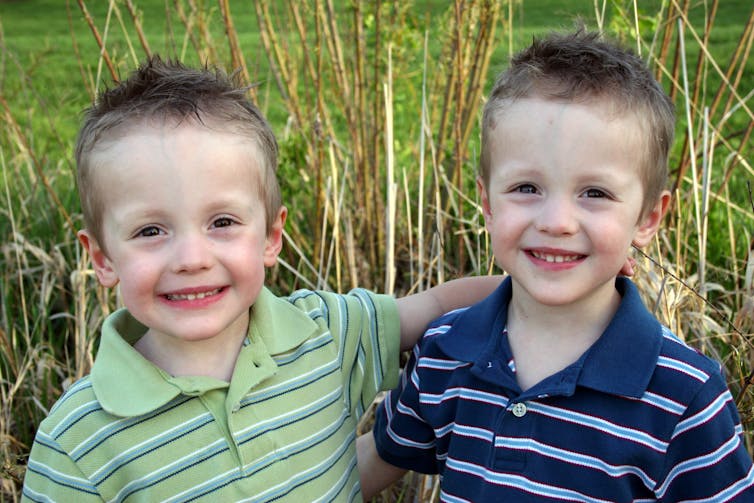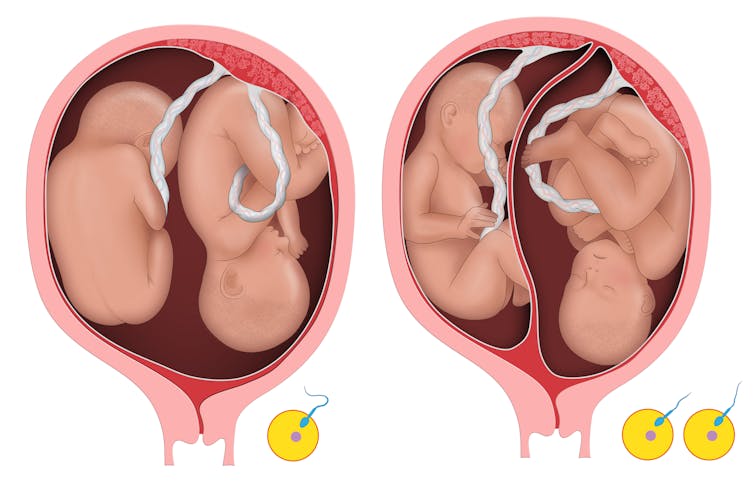
Alison McEwen, University of Technology Sydney and Chris Jacobs, University of Technology Sydney

If you have a question you’d like an expert to answer, send it to This email address is being protected from spambots. You need JavaScript enabled to view it..
Why are some twins identical and some not? - Chloe, age 12, Australia
We have spent many years explaining how genes work to people who would like to have children, so we’re happy to answer this excellent question.
There are two types of twins: fraternal and identical.
Fraternal twins may be born on the same day but are not genetically the same. They look different, have different genes and may be of the same sex or the opposite sex.
Identical twins, on the other hand, look the same, share the same birthday and share the same genes. They are the same sex, meaning they will both be girls or they will both be boys.
To understand why, we need to look at what happens at the time a pregnancy starts. We call the start of a pregnancy the time of conception.
Read more: Curious Kids: Why do people grow to certain sizes?
What happens when a woman becomes pregnant?
Most women produce one egg each month. Each time a man and woman have sex, the man produces thousands of sperm. If the man and woman have sex and do not use contraception (for example a condom, IUD or the Pill), there is a chance that a sperm will fertilise the egg and the woman will become pregnant.
Most of the time, a single egg is fertilised, and goes on to develop into a single baby. If the egg is not fertilised, the woman will soon have her period, which is the way a woman’s body prepares itself for a new egg to be fertilised the next month.
We call a fertilised egg a “zygote”. This is a good word to remember, as we use it to help us understand the different ways identical twins develop during pregnancy (and knowing a word like zygote might impress your science teacher one day).

How do identical twins happen?
As you may know, genes are the instructions that tell our bodies how to develop and grow. They are like a recipe for creating each of us as unique individuals.
We have two copies of each of our genes: one from our biological mother and one from our biological father. That’s why we look like both our mother and our father.
Identical twins happen when a zygote splits into two in the first few days after conception. They have come from a single egg and a single sperm, so they share the same genes as each other. The reason the zygote splits is thought to be inherited, which may be why some families have a few sets of identical twins.
Because identical twins come from a single zygote that splits in two, they have exactly the same genes – exactly the same recipe. They will both have the same coloured eyes and hair, and will look the same. Identical twins are always the same sex too – they will both be girls or they will both be boys.
How do non-identical twins happen?
Identical twins are also called monozygous twins. This just means that they have come from the same, single zygote (mono means “one”). Non-identical twins are sometimes called dizygous twins (di means “two”, so dizygous means two zygotes).
Earlier on, we said that most women produce one egg each month. Occasionally, a women will produce more than one egg in a month. Non-identical twins happen when a woman produces two eggs (in the same month) and both eggs are fertilised by two different sperm.
Unlike identical twins, non-identical twins do not share the same genes as each other. They grow together and share the same birthday, but they are only as related as any other brothers and sisters. Non-identical twins could both be girls, or both be boys, or could be one girl and one boy twin.

Interestingly, there are more non-identical twins in Australia now than there have been before. The number of twin pregnancies has grown over the past 30 years. This might be partly because women in countries like Australia are having children when they are older and the chance of a twin pregnancy increases as women get older (as they are more likely to produce more than one egg in the same month).
The chance of a twin pregnancy is also higher if a couple uses assisted reproductive technology to help them to become pregnant.
Read more: Curious Kids: how do babies learn to talk?
Hello, curious kids! Have you got a question you’d like an expert to answer? Ask an adult to send your question to This email address is being protected from spambots. You need JavaScript enabled to view it.
Alison McEwen, Head of Discipline of Genetic Counselling, Graduate School of Health, University of Technology Sydney and Chris Jacobs, Senior Lecturer, Graduate School of Health, University of Technology Sydney
This article is republished from The Conversation under a Creative Commons license. Read the original article.

